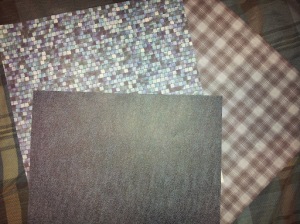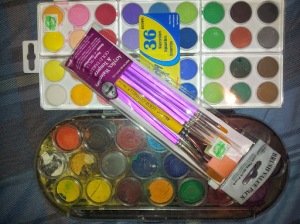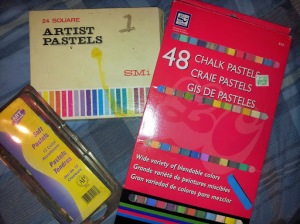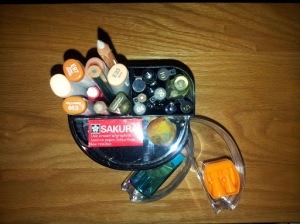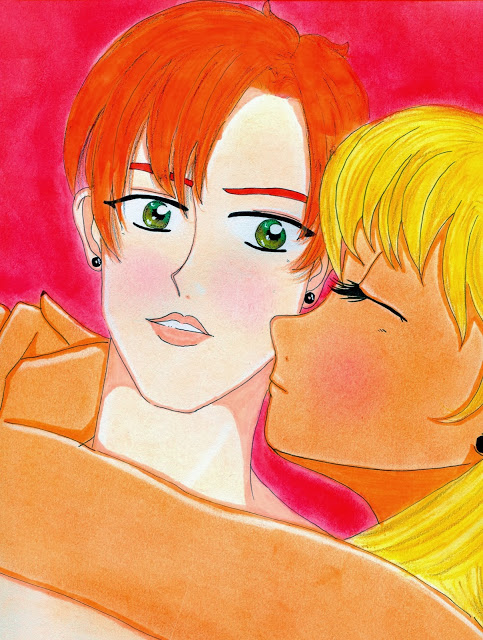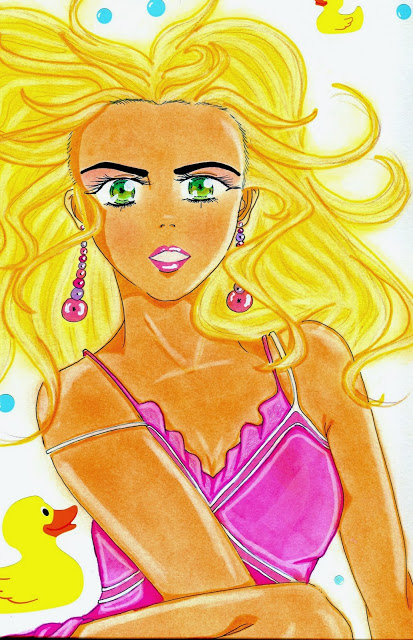So here we go. My first virtual portfolio. Enjoy...

Monday, November 25, 2013
Virtual Portfolio 2002-2013
Hi, Comic Towel readers. To sort of semi celebrate the one year closing of my small blog, I played around with Windows Movie Editor to create a virtual portfolio of many of the drawings I've shared throughout this year. As I mentioned before, there was a point where I stopped drawing completely because I didn't know what to do with my drawings. Nobody saw them, tucked away in my personal portfolios. So as a newly "invigorated" individual, I realized it was time to pull them out and this time share them through whatever available platform. What's even more interesting is that these drawings span eleven years (2002-2013). That in itself marks a small sense of personal significance to me.
So here we go. My first virtual portfolio. Enjoy...
So here we go. My first virtual portfolio. Enjoy...
Tuesday, November 12, 2013
Drawing Cakes #2-4 Blog Post
Here we are with the coloring process that I use in my drawings. I've provided links in the above video that navigate from videos 2, 3, and 4. Please enjoy, share and comment.
With that said, here lies the coloring tools that I use:
With that said, here lies the coloring tools that I use:
I usually combine drawing with crafting, so I wanted to make sure to point out that I love scrap-booking paper (as seen above). This type of paper comes in handy when you don't necessarily want to color/design a character's clothing or backdrop. It's also useful when you want to reach for something unique, different, and abstract to the eye. Now don't get me wrong, I love coloring in my own clothes and backgrounds; however, sometimes scrap-booking paper can do what I can't. They further help my vision come alive by popping with a different, dynamic set of colors alongside those that are hand produced. Sometimes they're tricky to use because you have to remove portions of the drawing to achieve the effect that you're after. But my goodness, when you get it right--you get it right. Especially with portrait-style drawings.
The brand of color pencils that I use are Prismacolor and, even more specifically, their soft core pencils. I use color pencils for a variety of techniques surrounding a drawing. However, the main purpose is for blending in the tones that make up the eye of the character. Example: If a character is blue-eyed, then I take three different shades of blue to create a gradient look to the eye. Nevertheless, I also use color pencil for small detailing and designing, but another important technique I use these for is character hair.
As seen in the video, I usually do a character's hair in four layers. I base paint it with water-color determined by the character's hair color of choice. (Note: if the character's hair color is black, I use a light purple or light blue base because black on black can come off as too heavy.) Then I use chalk pastels to further flesh out the color, giving it shape and dept. After this layer I find three shades of one matching color pencil, or two shades and an automatic black color pencil, to draw and add flair to the character's hair before the final layer of highlighting the character's hair via an eraser. This eraser layer gives the hair movement.
I love water coloring mostly for small details, filling large spaces, and background flourishes. Nevertheless, the majority of its us is for adding a base color to another layer of color using a different tool. Occasionally it's the opposite way around where I use another type of coloring tool (such as a coloring pencil) as a base and use water colors to fill everything in further. In any regard, I like water color because it's light enough for blending and strong enough that you can cover/color over certain areas that aren't coming alive like you'd hope. Furthermore, it's just fun!
Chalk pastels are probably my favorite coloring tool. Back in the day these were the tools that really took my drawings to another level of applied techniques. And I've stuck with what I've learned till this day. See, I didn't have money for expensive markers and had to make due with what was available to me. Luckily, an old art teacher had an old set of chalk pastels that I could use to explore my passion with after she taught us a few tricks on using them during a school project. While chalk pastels can be messy (even ruining a drawing) and take careful use to control, the way they blend over wide spaces is just unbeatable, considering what I'm trying to achieve with a particular drawing. And because it can be a little too harsh when applying darker shades, you also have the added benefit of merging two different tones to keep a happy medium. There is just something soothing about blending with chalk pastels, which is why I've stuck with them despite their messiness.
---------------------------------------
Okay! Those are my coloring tools that I use. Occasionally, I find a reason to use oil pastels, crayons, and acrylic paint. I also have been known to use hair color spray and other scrap booking materials such as stickers and plastic gems. Once the drawing is scanned, I carefully decide whether or not it can use the Revive Color filter or not in my design program; physical and digital prints usual look differently to me.
Whatever it takes to honor a vision, I say.
And last but not least, a scan of the finally results from the video series Drawing Cakes...
 |
| Michael Yoon's Legend |
Thanks for reading and watching this series of posts and videos. I hope it inspires those who are looking for ideas. And just remember that when you express yourself through drawing--whatever that may be--remind yourself that you're a pipeline of ideas that will never dry up. Keep going. Keep exploring. Keep imagining. Don't let anyone tell you that what you envision and produce is less than another form of art. If it's in you, it's there for a reason. It's there to be expressed, not stifled down.
If you miss Drawing Cakes #1 post on inking, here is the link: http://www.comictowel.com/2013/11/drawing-cakes-1-blog-post.html
Tuesday, November 5, 2013
Drawing Cakes #1 Blog Post
Okay guys, here is a little more details into the pencils, pens and markers I use to draw with. But first, you need a sweet container to carry all of them. Such as this cool one I found...
Little drawers for erasers and pencil sharpers.
Slim, compact, and easy access.
You need paper to draw on, naturally. Personally, I am enamored with Bristol paper. Matter-of-fact, I'm kind of obsessed with it. Before I used regular premium drawing paper. Then I discovered that the stock of Bristol paper works better for me. I like it because it works well with the crafting aspect of many of my drawings. Plus, there's just something reliable about this type of paper. Its hardness appeals to my drawing muse (^_^). This particular pad is from recycled paper, which is always great to pick from to "do your part".
Nothing but gentle block style erasers work for me during the sketching process. You definitely don't want to use anything super abrasive like Pink Pearl. White, clean, and gentle is the way to go. The same applies for the eraser pen that helps with small lines. I have two pencil sharpeners. One seems to work better with the color pencils I use while the other for regular drawing pencils. Other than that, I lose sharpeners a lot. Because I mix drawing with crafting, I also have an X-Acto Knife handy. You'll soon see why.
The start of every sketch: pencils. With the exception of the two blending pencils (those with the white tips), I use the lightness of H and 2H pencils. Something like 2B or beyond 2H is entirely too harsh for me. The difference is the lead in the pencil. The higher the number and letter combination, the stronger the lead is in the pencil. So H and 2H has a softer lead material than something like a 9H drawing pencil. You could say that I like to sketch almost invisibly, but I'm always mindful of possible lines dug into the paper because of hard sketching. While I do have a mechanical pencil shown here, I rarely use it. I love my wood and lead combo. Therefore, H and 2H remain my favorite sketching pencils.
Time for ink. But first I should share something you should be aware of before you move from the sketching stage: LOOK AT YOUR SKETCH THROUGH A MIRROR! That's right. Take your sketch and look at it through a mirror. Through its reflection, you will see just about every uneven line, swoop, or curve that your eye doesn't catch otherwise. I learned this a long time ago. It works especially for someone like myself who loves to draw portraits of pretty manga-inspired characters. Nevertheless, I wouldn't be so hard on myself should I miss something. Sometimes you got to let mishaps be.
This here is a small collection of the ink pens I use after a sketch. I do have a calligraphy pen that holds speedball types A, B, C, D. It's fun dipping into India ink, but I haven't used it in a while because I don't care too much for the grip. It's not too necessary. This set here is helpful because each tip provides a different gradient for what you want to achieve in your drawing. If you want a really heavy line, you'll use a 1.0mm sized pen. A little thicker? Try the 0.6mm pen. The Faber-Castell pen at the top uses India ink and its marked with B for Big or even Bold. Because I bought this brand in a kit, there is also an M for Medium and S for Small and XS for Extra Small.
The funny thing about many of the pens here is that the smaller pens dry out to quickly. Which is fine because the best--and absolute BEST--inking pen is...
...this one! I got a close snapshot of the name and style. You can take a note and buy it at Wal-Mart (that's right) in a two-pack deal. This pen is amazing. For someone who sketches neatly and inks just as neatly, this pen saved me a lot of headache because I don't color as neatly. The tip is so fine, so precise (as the pen states), that it just makes your inked sketch look so delicate and clean for color. I could go on and on about this pen, but I won't. A funny observation I noticed is that it dries slower on paper than a lot of the other pens I mentioned. Therefore, give yourself a second after inking to erase pencil lines.
Everybody who is inspired by manga art knows about Copic Sketch markers shipping over from Japan. People use either Copic or Prismacolor. I own a few of both, and yeah, Copic is probably my most preferred. Why? Mainly because they don't dry up nearly as fast as Prismacolor and they are superior for blending with my other coloring methods. That's just my experience, though. Needless to say, both brands are expensive--and rightfully so considering how amazing they are. Thankfully, I don't use either to color my drawings (the next post will be dedicated to my coloring methods), and that's not because I am too cheap. I'm simply not a fan of using markers to color entire drawings. I don't like the back-and-forth of markers over wide spaces, if that makes sense.
With all that said, I own only flesh-tone Copic markers that I use for shadowing and outlining characters. I'll be sharing this in the next video.
Thanks to those who read all of this and please feel free to share any ideas, methods or drawing tools.
The next post and series of videos on coloring can be found here: http://www.comictowel.com/2013/11/drawing-cakes-2-4-blog-post.html
Thursday, October 31, 2013
India.Arie's "Break the Shell"
I just had to share this song by India.Arie. Since her latest album, SongVersation, came out back in June, I’ve been trying to find ways to share my love of its material through my blog. There is just so much to examine on this album, and so many lessons in relation to our lives as we try to better ourselves. All of this is told consciously through Arie's amazing voice, of course. And since I like taking a closer look at life here, I felt like this album would provide a perfect source to do so.
The song I’m featuring is India.Arie’s song “Break the Shell”, a powerful song about feeling and living life while in display of our vulnerabilities. Many times we allow our past and circumstances to build walls around us, walls that keep us from breaking out into our Truth and living the life that we desire. How often do we suffocate our Truth to maintain that veneer of personal dishonesty, or to feel connected with others while disconnected inside? What kind of freedoms do when gain when we break down our walls and allow the world to see us fly? Listen to the performance, read the lyrics, and decide.
The song I’m featuring is India.Arie’s song “Break the Shell”, a powerful song about feeling and living life while in display of our vulnerabilities. Many times we allow our past and circumstances to build walls around us, walls that keep us from breaking out into our Truth and living the life that we desire. How often do we suffocate our Truth to maintain that veneer of personal dishonesty, or to feel connected with others while disconnected inside? What kind of freedoms do when gain when we break down our walls and allow the world to see us fly? Listen to the performance, read the lyrics, and decide.
"Break the Shell"
I met a prophet dark as the night
She could see into my soul
Said she'd been watching and had some advice
She said shadows make you whole
A Life without pain is a wolf in sheep's clothes
'Cause if you listen to the lessons that it holds, you'll
find the gold
Child it's time to break the shell
Life's gonna hurt but it's meant to be felt
You cannot touch the sky from inside yourself
You cannot fly, until you break the shell
I can remember when I was a child
How the grown folks seemed so crazy
Why are they so angry? Why are they so loud?
And when I grow up that's never, ever gonna be me
That was the moment that I decide
That I would build a wall just shy of 6 feet tall, too
strong to fall
Child it's time to break the shell
Life's gonna hurt but it's meant to be felt
You cannot touch the sky from inside yourself
You cannot fly, until you break the shell
Courage is not being hard
It's time to peel back all the layers
You put between who you're meant to be
And who you are
And go be who you are
So much disappointment to finally understand
That there is no such thing as perfect
We're all simply doing the best that we can
And we have the choice to live or truly be alive
This is your life
Child it's time to break the shell
Life's gonna hurt but it's meant to be felt
You cannot touch the sky from inside yourself
You cannot fly, until you break the shell
Child it's time to break the shell
Life's gonna hurt but it's meant to be felt
You cannot touch the sky from inside yourself
You cannot fly, until you break the shell
Do with these words what you will
It's time for us to be for real
You'll be stuck on the ground until
You finally break the shell
Sunday, October 27, 2013
Digging for Gold!
Well, it's Comic Towel, my mix-up of drawings, literature, and self-help. Here's a drawing I did per request. It didn't fit the request, but I love it too much to ignore. The funny thing is that I started two drawings for the request and got to the coloring part of the other before I realized I didn't like it. Whereas, I didn't like this picture in its sketched form. However, I kept digging at it. Drawing, inking, coloring, experimenting. And I feel like I dug out some gold. It might not've fit the request of the individual who asked for it, but I feel like this drawing showed me that I was able to do exactly what I set out to do here. You got to keep digging. Never give up.
I put this colorful drawing together during July. I wanted to post it with a short story but never really got to writing the piece. So I just held on to the drawing. Then I realized that--hey--it's in me to want to draw. I'm an unlimited, abundance system of ideas. Not to sound cheeky about it, though. I believe that each drawing is a learning experience. In any regard, I grew tired of waiting to share the drawing. So here it is. The dude kind of reminds me of Wheeler from Captain Planet. Would you say so too?
This is an archive picture I wanted to share. For some reason I never quite added it to my Zazzle shop deal. But I always look at it trying to figure out why not. So. I'll just share it here until I get my shit together about it.
Meanwhile, I need suggestions on where I can start doing commission work. I had a gig on Fiverr then decided to take it down only because I needed to reconstruct my time and planning. Any ideas?
Saturday, October 26, 2013
Thoughts on African American Literature
The category of ethnic literature that focuses on African American literature is many times defined as literature that tackles subjects of black identity, oppression, segregation, and civil challenges. Historical events such as slavery, Jim Crow Laws, and Supreme Court cases that favored African American individuals helped influence the growth of this literature. Many African Americans participated in announcing their voice to the public because of these events. Mothers, fathers, students, scientists, business owners, and artist forced their expression on the subject during the decades that built into the establishment of African American literature. As African American literature grew to challenge discrimination and social enforcing laws, so did the popularity of its writers. From the beginnings of Harriet A. Jacobs and Frederic Douglass, to contemporary authors Terry McMillian and Alice Walker, each has contributed to defining the scope of African American literature and what it means in America. Some may consider this form of literature limited in its subject matter, themes, and conventions as it portrays one condition of the American experience; however, through careful literary conventions and material that echo historical and socio-political events, African American literature presents boundless voices similar to those of “traditional” literature.
There is much to consider when one embarks on understanding African American fiction. Like “traditional” American fiction, literary conventions, and themes must be taken into consideration as well as the tone and voice of the material. Themes spreading from any amount of literature, informs readers what the material is about. Layers of the writer’s construction through dialogue, setting, and narrative form the theme. Many times readers decide, through his or her interpretation, what the theme of a novel is. Nevertheless, theme drives the material just as well as literary conventions. Therefore, themes ground literary material regarding its reason, and conventions guide readers through the “rules” concerning each event that takes part in the story to make up the theme.
Three examples of African American literary fiction that display an array of literary themes and conventions are "Incidents in the Life of a Slave Girl" by Harriet A. Jacobs, "Sweat" by Zora Neale Hurston, and "We Wear the Mask" by Paul Laurence Dunbar.
Before African Americans experienced freedom, they largely experience slavery. Harriet A. Jacobs’s “Incidents in the Life of a Slave Girl” provides a clear illustration concerning the struggles and mistreatment during a period when human rights were of no consideration. As a memoir detailing the accounts of a slave girl who hid away from her master for seven years, the conventions Jacobs provided to motivate her theme were consistent with the troubles slaves faced. Her memoir is also driven by concepts of family and separation as well as the confinement one must endure (as well as escape) in his or her pursuit of freedom. Because the material is a biography, Jacobs chronologically manages to move her material through each preceding event that affects her resolution and purpose in telling her story.
Examples of Jacobs’s chronology of events are the swap between her experience with new masters, her incidents in Philadelphia, and her eventual escape. These are successfully employed the biography’s convention to uncover the purpose of her biography as well as the theme. Through expressing the theme of the desire for freedom during the horrors of slavery, Jacobs captured the attention of a period filled with historical and socio-political discord. Her autobiography persisted with the country’s urging for change during the Civil War era as well as becoming a staple for the nation to consider the horrors of past events when making changes for its future.
Zora Neale Hurston’s “Sweat” features Delia, a washerwoman, and her abusive husband. It takes the desperation for family from “Incidents” and illustrates a painful view of it. The washerwoman’s husband is abusive to his wife, angered by her desire to keep the clothing of white people together and in order. He also cheats on her repeatedly. As the story progress, so does the time. The readers see Delia continues to wash, and she remains secondary to her husband as he continues to fulfill the needs of his mistress. It is when her husband brings home a rattlesnake that Delia’s side of the situation changes. Through a turn of events, her husband is bitten by the snake, and instead of sending for help, Delia simply watches him die. She escapes another form of confinement: marriage.
As a fiction story, “Sweat” offer readers a subtle set of themes to explore. One will start with Delia’s husband’s dependency on his wife as the breadwinner and how this often made him angry. In large part he is inept in their family situation; therefore, he sought the attention of another woman. Even the men outside the marriage, who were aware of Delia’s husband’s affection with another woman, choose not to impose on the marriage to save Delia. However, during the period in which the story was written there were no convenience divorces, especially at the request of women. This concept was more extreme in the case of African American women. Therefore, Delia found her way out through the snake that bit her husband, reiterating both the desperate attempts she would take for freedom.
"We Wear the Mask" by Paul Laurence Dunbar follows “Incident” and “Sweat” as a poem that furthers the African American experience by best describing the emotions within the two. “We Wear the Mask” illustrates the African American experience of hiding oneself to appeal to the public, particularly during slavery, and the Jim Crow era. Dunbar wanted to express how a person will look one way in his or her outer appearance but what goes on inside is of a different accord. Much like Jacobs’s narrative, and Hurston’s character of Delia, the women have to resource to containing her inner struggles because of the consequences expressing them will have. However, when desperate, their true feelings emerged at the thought of freedom from suppression. Nevertheless, Dunbar’s poem encompasses the struggles of many African Americans throughout history. These individuals relied on inner strength to battle persecution, and Dunbar asks that individuals of the present learn from the past to no longer hide themselves or suffer through the ideal that an individual cannot be free from another.
African American fiction employees a variety of literary conventions, themes, and subjects to make up the entirety of American literature. Whether the material is a biography, piece of fiction, or poem, its purpose is to provide a voice to a group of individuals who remained disregarded in “traditional” literature as well as reality. Providing elements of myths and traditions, this category of literature is filled with messages related to family and self-acceptance. It is literature that stretches the problems faced during slavery to the conditions faced in return during today’s era.
Monday, October 21, 2013
Tao and Satisfaction
I’m pretty sure we all believed or have stated that we don’t ask for much from people and life; whether that‘s outwardly true it's what we inwardly believe. We attempt to be comfortable in our given--or created--situations. We focus and strive for the biggest, most desired bit of transformation that we feel is required to bloom order and fulfillment into our lives. We think that maybe if we get that one thing to happen, everything else will fall into place. Or maybe those other annoyances concerning life wouldn't matter; fading away as we travel through our passions and destinies toward greatness So when we've obtained our “big picture”, lying comfortably within it, where do we go from there? And what is it about wanting more after receiving?
As I've read the third verse/chapter of the Tao through Dyer’s book and Derek Lin’s translation, I come to realize that learning how to be satisfied with life’s little unfoldings might be more of a fantasy than reality. Like many, I've been condition to want so badly that I don’t believe it is even possible for me to reach such a level of content. A level so strong that it blocks out all of my egocentric-driven desires. See, I’m not sure where and when it happened, but life always just feels like a fight. Like everybody else, I’m constantly contending with deep levels of inner habituations and outer influences. So what am I (or we) left with when we travel through the two different verses of the Tao’s third verse/chapter translation? Verses that ask us to let down our guard and relax ourselves on this plane by being auto-piloted by our spirits. As always, let’s look at Dyer’s version then Lin’s.
Dyer’s translation reads as:
As always, I connect with Lin’s version better. Yet, I always read his like poetry while in need of Dyer’s interpretation to sort of reorient any of my thoughts. Nevertheless, I think at its basis, this verse/chapter is simple and clear: let life do the heavy lifting and just show gratitude for what is as is unfolds into the purist form of your desires. If you can’t accept things as they are and be appreciative, then you’ll always be in want of something. Nevertheless, as I mentioned, it would take me tons of work to get pass my ego in order to reach such a state. However, in many ways it really comes down to a single conscious thought for promoting inner change. That nugget of information is there--it's with you now. Depending on how persistent you are for change, you'll always have access to it. So if you can at least program yourself (unless or until it comes unconsciously) to recognize situations that ask you to allow life to be, then you can make the conscious decision to do so when said situation arises. That's a good place to start in my opinion. It's an idea that helps many people who are just starting on spiritual paths or paths for change. Because think about it, at one point you didn't have the tools necessary to change. You were just bumbling about. So maybe that'll be enough for now. Recognizing the opportunities to step back and let life do the heavy lifting.
Sources
Dyer, Wayne W. Change Your Thoughts, Change Your Life: Living the Wisdom of the Tao. Carlsbad, CA: Hay House, 2007.
Lin, Derek. “Accurate Translation of the Tao Te Ching.” Accurate Translation of the Tao Te Ching. N.p. <http://www.taoism.net/ttc/complete.htm>.
As I've read the third verse/chapter of the Tao through Dyer’s book and Derek Lin’s translation, I come to realize that learning how to be satisfied with life’s little unfoldings might be more of a fantasy than reality. Like many, I've been condition to want so badly that I don’t believe it is even possible for me to reach such a level of content. A level so strong that it blocks out all of my egocentric-driven desires. See, I’m not sure where and when it happened, but life always just feels like a fight. Like everybody else, I’m constantly contending with deep levels of inner habituations and outer influences. So what am I (or we) left with when we travel through the two different verses of the Tao’s third verse/chapter translation? Verses that ask us to let down our guard and relax ourselves on this plane by being auto-piloted by our spirits. As always, let’s look at Dyer’s version then Lin’s.
Dyer’s translation reads as:
Will create contentiousness.
If you overvalue possessions,
People begin to steal.
By not displaying what is desirable, you will
Cause the people’s hearts to remain undisturbed.
The sage governs
By emptying minds and hearts,
By weakening ambitions and strengthening bones.
Practice not doing…
When action is pure and selfless,
Everything settles into its own perfect place.
And Lin’s reads:
Do not glorify the achievers
So the people will not squabble
Do not treasure goods that are hard to obtain
So the people will not become thieves
Do not show the desired things
So their hearts will not be confused
Thus the governance of the sage:
Empties their hearts
Fills their bellies
Weakens their ambitions
Strengthens their bones
Let the people have no cunning and no greed
So those who scheme will not dare to meddle
Act without contrivance
And nothing will be beyond control
Sources
Dyer, Wayne W. Change Your Thoughts, Change Your Life: Living the Wisdom of the Tao. Carlsbad, CA: Hay House, 2007.
Lin, Derek. “Accurate Translation of the Tao Te Ching.” Accurate Translation of the Tao Te Ching. N.p. <http://www.taoism.net/ttc/complete.htm>.
Subscribe to:
Posts (Atom)
